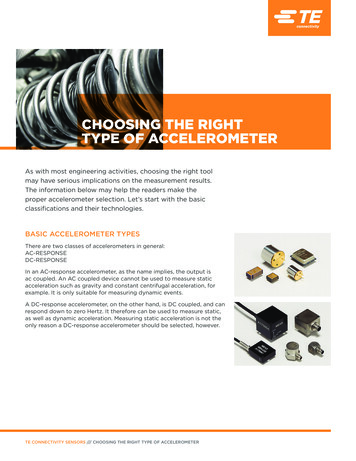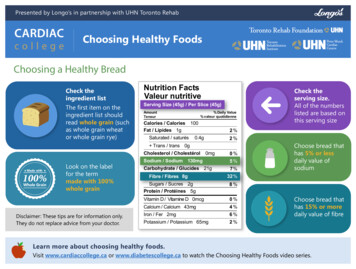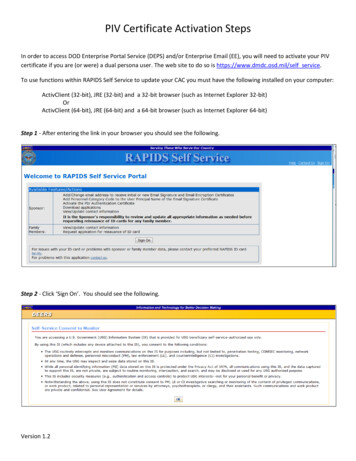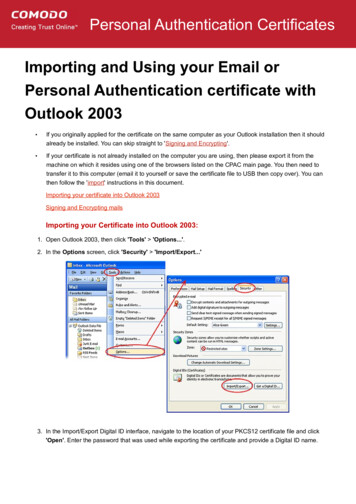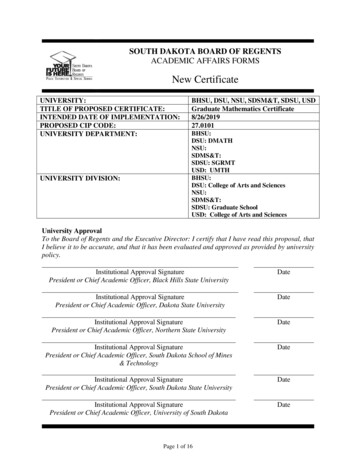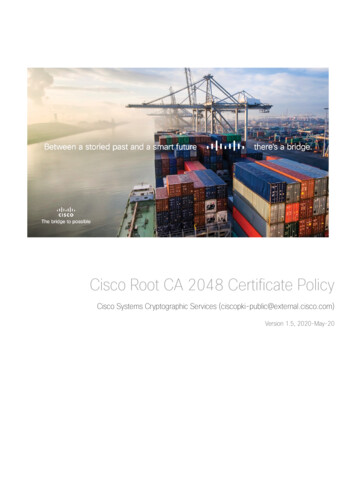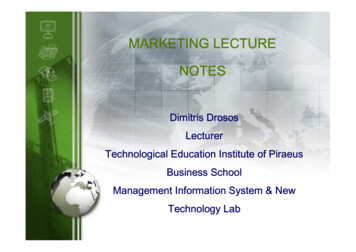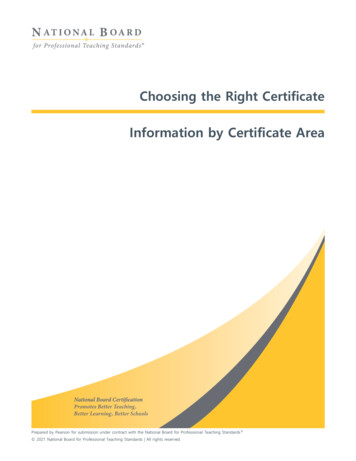
Transcription
Choosing the Right CertificateInformation by Certificate AreaPrepared by Pearson for submission under contract with the National Board for Professional Teaching Standards 2021 National Board for Professional Teaching Standards All rights reserved.
ContentsThis document is a reference guide for candidates seeking National BoardCertification to use when deciding which of the 25 certificate areas, listedbelow, to apply for.ArtEarly and Middle Childhood . 1Early Adolescence through Young Adulthood . 2Career and Technical EducationEarly Adolescence through Young Adulthood . 3English as a New LanguageEarly and Middle Childhood . 5Early Adolescence through Young Adulthood . 6English Language ArtsEarly Adolescence . 7Adolescence and Young Adulthood . 8Exceptional Needs SpecialistEarly Childhood through Young Adulthood . 9GeneralistEarly Childhood . 11Middle Childhood . 12Health EducationEarly Adolescence through Young Adulthood . 13Library MediaEarly Childhood through Young Adulthood . 14 2021 National Board for Professional Teaching Standards All rights reserved.
Literacy: Reading–Language ArtsEarly and Middle Childhood . 15MathematicsEarly Adolescence . 16Adolescence and Young Adulthood . 17 2021 National Board for Professional Teaching Standards All rights reserved.
Contents (continued)MusicEarly and Middle Childhood . 18Early Adolescence through Young Adulthood . 19Physical EducationEarly and Middle Childhood . 20Early Adolescence through Young Adulthood . 21School CounselingEarly Childhood through Young Adulthood . 22ScienceEarly Adolescence . 23Adolescence and Young Adulthood . 24Social Studies–HistoryEarly Adolescence . 25Adolescence and Young Adulthood . 26World LanguagesEarly Adolescence through Young Adulthood . 27 2021 National Board for Professional Teaching Standards All rights reserved.
Early and Middle Childhood/ArtChoosing the Right CertificateEarly and Middle Childhood/ArtThe Early and Middle Childhood/Art certificate is appropriate for teachers who know the makingand content of the visual arts and who teach visual arts to students ages 3–12. To successfullyachieve certification in this area, you will be assessed on whether your content knowledge andteaching practice meet the Early Childhood and Middle Childhood/Art Standards.Your certification assessment will include one computer-based assessment of content knowledge administered at a testingcenter. You must complete 3 constructed response exercises and 45 selected responseitems. three portfolio assessments in which you demonstrate your accomplished teachingpractice. You must have access to a class of at least 6 students, in which 51% of thestudents are ages 3–12. Except when otherwise noted in component-specific instructions,all evidence of your work with students must be gathered no earlier than the 12 monthsprior to the opening of the ePortfolio Submission Window.For information about the full certification process, eligibility requirements, and applicationinstructions, read the Guide to National Board Certification. Find detailed informationabout the above assessment components for each certificate area atwww.nbpts.org/certification/candidate-center/. If you have further questions, you may wish todiscuss your teaching situation with professional colleagues, your school faculty, a NationalBoard Certified Teacher, your faculty support group, or a local-level administrator who isdirecting a National Board program.1 2019 National Board for Professional Teaching Standards All rights reserved.
Early Adolescence through Young Adulthood/ArtChoosing the Right CertificateEarly Adolescence through Young Adulthood/ArtThe Early Adolescence through Young Adulthood/Art certificate is appropriate for teacherswho teach visual arts to students ages 11–18 and who know the making and content of thevisual arts. To successfully achieve certification in this area, you will be assessed on whetheryour content knowledge and teaching practice meet the Early Adolescence through YoungAdulthood/Art Standards.Your certification assessment will include one computer-based assessment of content knowledge administered at a testingcenter. You must complete 3 constructed response exercises and 45 selectedresponse items. three portfolio assessments in which you demonstrate your accomplished teachingpractice. You must have access to a class of at least 6 students, in which 51% of thestudents are ages 11–18 . Except when otherwise noted in component-specificinstructions, all evidence of your work with students must be gathered no earlier thanthe 12 months prior to the opening of the ePortfolio Submission Window.For information about the full certification process, eligibility requirements, and applicationinstructions, read the Guide to National Board Certification. Find detailed informationabout the above assessment components for each certificate area atwww.nbpts.org/certification/candidate-center/ . If you have further questions,you may wish to discuss your teaching situation with professional colleagues, your schoolfaculty, a National Board Certified Teacher, your faculty support group, or a local-leveladministrator who is directing a National Board program.2 2021 National Board for Professional Teaching Standards All rights reserved.
Early Adolescence through Young Adulthood/Career and Technical EducationChoosing the Right CertificateEarly Adolescence through Young Adulthood/Career andTechnical EducationThe Early Adolescence through Young Adulthood/Career and Technical Education certificate isappropriate for teachers who teach career and technical information subjects and who knowindustry-specific subject matter. To successfully achieve certification in this area, you will beassessed on whether your content knowledge and teaching practice meet the Career andTechnical Education Standards.Your certification assessment will include one computer-based assessment of content knowledge administered at a testingcenter. You must complete 3 constructed response exercises and 45 selected responseitems. three portfolio assessments in which you demonstrate your accomplished teachingpractice. You must have access to a class of at least 6 students, in which 51% of thestudents are ages 11–18 . Except when otherwise noted in component-specificinstructions, all evidence of your work with students must be gathered no earlier than the12 months prior to the opening of the ePortfolio Submission Window.The Early Adolescence through Young Adulthood/Career and Technical Education certificate areaincludes the following paths: Business, Marketing, and Financial Services. Teachers in this path focus oneducation for, and about, business. The academic and occupational content of this careercluster addresses business, management, and administration; finance; and marketing,sales, and services. Community Services. Teachers in this path instruct students in government services,law and public safety, health services, and human services. Government servicescomprise the planning and implementation of public administration activities on a local,state, and national level, while law and public safety addresses law enforcement,correctional services, and fire science. Health services encompass diagnostic, therapeutic,and medical laboratory services, as well as nursing, health informatics, and health careadministration and management. The area of human services includes child and familyservices, counseling and mental health, consumer services, food and nutrition,cosmetology, interpretation, and teacher training. Decorative Arts and Design. Teachers in this path provide students with the technicaland business skill sets they need to obtain employment in major industries or as artisansin cottage industries, such as apparel design and clothing construction, ceramics andpottery, floral arrangement, interior design and decorating, jewelry making, and textiledesign. Engineering, Design, and Fabrication. Teachers in this path prepare students toundertake tasks such as building electronics, repairing roadways, constructing buildings,maintaining and servicing power plants, and designing new products. They introduce theirstudents to new tools and machinery, technologies and materials, processing andfeedback controls, and outputs and robotics. Information Systems and Technology, Communications, and the Arts. Teachers inthis path show their students how to use words, sounds, signs, and symbols to createmeaning. Practitioners specialize in a range of fields—including communications andjournalism, fine and performing arts, information systems and technology, and mediaarts—but the purpose of their activities centers on communication.3 2021 National Board for Professional Teaching Standards All rights reserved.
Early Adolescence through Young Adulthood/Career and Technical EducationChoosing the Right Certificate Leisure and Recreation Services. Teachers in this path prepare their students forcareers in culinary arts, entertainment management, event marketing, food andbeverage service, hospitality and tourism, and sports management. Teachers have abroad knowledge of business functions related to resource and information management,communications, and customer service, which they couple with technical skills withintheir field of expertise. Natural Resources. Teachers in this path teach courses in agriculture, food, and naturalresources. They have an in-depth understanding of life science and possess industryspecific knowledge related to commerce, communication, economics, entrepreneurship,finance, and policy within the realm of natural resources. The coursework that theseteachers provide is often classified within seven broad categories: agribusiness systems;animal systems; energy systems; food products and processing systems; naturalresource systems; plant systems; and power, structural, and technical systems. Transportation Systems and Services. Teachers in this path specialize in vehiclemechanics and transportation networks. Training in this career pathway providesstudents with the experience they need to pursue careers as automotive technicians,aviation pilots and mechanics, heavy equipment operators, collision repair specialists,and warehouse managers, among others.For information about the full certification process, eligibility requirements, and applicationinstructions, read the Guide to National Board Certification. Find detailed informationabout the above assessment components for each certificate area atwww.nbpts.org/certification/candidate-center/. If you have further questions, you may wish todiscuss your teaching situation with professional colleagues, your school faculty, a NationalBoard Certified Teacher, your faculty support group, or a local-level administrator who isdirecting a National Board program.4 2021 National Board for Professional Teaching Standards All rights reserved.
Early and Middle Childhood/English as a New LanguageChoosing the Right CertificateEarly and Middle Childhood/English as a New LanguageThe Early and Middle Childhood/English as a New Language certificate is appropriate for teacherswho teach linguistically and culturally diverse learners ages 3–12 and who know the range of theearly and middle childhood curriculum. To successfully achieve certification in this area, you willbe assessed on whether your content knowledge and teaching practice meet the English as a NewLanguage Standards.Your certification assessment will include one computer-based assessment of content knowledge administered at a testingcenter. You must complete 3 constructed response exercises and 45 selected responseitems. three portfolio assessments in which you demonstrate your accomplished teachingpractice. For each portfolio component, you must have access to a class of at least 3students, in which 51% of the students are ages 3–12. Except when otherwise noted incomponent-specific instructions, all evidence of your work with students must begathered no earlier than the 12 months prior to the opening of the ePortfolio SubmissionWindow.The Early and Middle Childhood/English as a New Language certificate area includes the followingpaths: Path 1 is an assessment of the English as a New Language Standards and is designed forbilingual teachers (the term "bilingual" is used here in a nonspecific sense to identify theteacher who uses both English and another language in instruction) who would like toachieve certification within the English as a New Language framework while alsodemonstrating their accomplishment as Early Childhood or Middle Childhood Generalists.All candidates must show in their portfolio entries that they are fostering English languagedevelopment within their bilingual context. At the assessment center, they will completeexercises in their respective generalist areas. Path 2 is also an assessment of the English as a New Language Standards and isdesigned for teachers who identify themselves as English Language DevelopmentSpecialists (ELDS) (ELDS is used here to identify the teacher who is an English languagedevelopment specialist and who may or may not use the students' first language ininstruction).All candidates must show in their portfolio entries that they are fostering English languagedevelopment. At the assessment center, they will complete exercises focusing on theirknowledge of English language development.For information about the full certification process, eligibility requirements, and applicationinstructions, read the Guide to National Board Certification. Find detailed informationabout the above assessment components for each certificate area atwww.nbpts.org/certification/candidate-center/. If you have further questions, you may wish todiscuss your teaching situation with professional colleagues, your school faculty, a NationalBoard Certified Teacher, your faculty support group, or a local-level administrator who isdirecting a National Board program.5 2021 National Board for Professional Teaching Standards All rights reserved.
Early Adolescence through Young Adulthood/English as a New LanguageChoosing the Right CertificateEarly Adolescence through Young Adulthood/English as aNew LanguageThe Early Adolescence through Young Adulthood/English as a New Language certificate isappropriate for teachers who teach linguistically and culturally diverse learners ages 11–18 andwho know the range of the early adolescence through young adulthood curriculum. Tosuccessfully achieve certification in this area, you will be assessed on whether your contentknowledge and teaching practice meet the English as a New Language Standards.Your certification assessment will include one computer-based assessment of content knowledge administered at a testingcenter. You must complete 3 constructed response exercises and 45 selected responseitems. three portfolio assessments in which you demonstrate your accomplished teachingpractice. For each portfolio component, you must have access to a class of at least 3students, in which 51% of the students are ages 11–18 . Except when otherwise notedin component-specific instructions, all evidence of your work with students must begathered no earlier than the 12 months prior to the opening of the ePortfolio SubmissionWindow.The Early Adolescence through Young Adulthood/English as a New Language certificate areaincludes the following paths: Path 1 is an assessment of the English as a New Language Standards and is designed forbilingual teachers (the term "bilingual" is used here in a nonspecific sense to identify theteacher who uses both English and another language in instruction) who would like toachieve certification within the English as a New Language framework while alsodemonstrating their accomplishment as Early Adolescence (EA) or Adolescence and YoungAdulthood (AYA) content specialists in Mathematics, Science, or Social Studies–History.All candidates must show in their portfolio entries that they are fostering Englishlanguage development within their bilingual context. At the assessment center, they willcomplete exercises in their respective content areas. Path 2 is also an assessment of the English as a New Language Standards and isdesigned for teachers who identify themselves as English Language DevelopmentSpecialists (ELDS) (ELDS is used here to identify the teacher who is an Englishlanguage development specialist and who may or may not use the students' firstlanguage in instruction).All candidates must show in their portfolio entries that they are fostering Englishlanguage development. At the assessment center, they will complete exercises focusingon their knowledge of English language development.For information about the full certification process, eligibility requirements, and applicationinstructions, read the Guide to National Board Certification. Find detailed informationabout the above assessment components for each certificate area atwww.nbpts.org/certification/candidate-center/. If you have further questions, you may wish todiscuss your teaching situation with professional colleagues, your school faculty, a NationalBoard Certified Teacher, your faculty support group, or a local-level administrator who isdirecting a National Board program.6 2021 National Board for Professional Teaching Standards All rights reserved.
Early Adolescence/English Language ArtsChoosing the Right CertificateEarly Adolescence/English Language ArtsThe Early Adolescence/English Language Arts certificate is appropriate for teachers who teachstudents ages 11–15 and who know the full range of the school language arts curriculum,including reading, writing, listening, and speaking. To successfully achieve certification in thisarea, you will be assessed on whether your content knowledge and teaching practice meet theEnglish Language Arts Standards.Your certification assessment will include one computer-based assessment of content knowledge administered at a testingcenter. You must complete 3 constructed response exercises and 45 selected responseitems. three portfolio assessments in which you demonstrate your accomplished teachingpractice. You must have access to a class of at least 6 students, in which 51% of thestudents are ages 11–15. Except when otherwise noted in component-specificinstructions, all evidence of your work with students must be gathered no earlier than the12 months prior to the opening of the ePortfolio Submission Window.For information about the full certification process, eligibility requirements, and applicationinstructions, read the Guide to National Board Certification. Find detailed informationabout the above assessment components for each certificate area atwww.nbpts.org/certification/candidate-center/. If you have further questions, you may wish todiscuss your teaching situation with professional colleagues, your school faculty, a NationalBoard Certified Teacher, your faculty support group, or a local-level administrator who isdirecting a National Board program.7 2021 National Board for Professional Teaching Standards All rights reserved.
Adolescence and Young Adulthood/English Language ArtsChoosing the Right CertificateAdolescence and Young Adulthood/English Language ArtsThe Adolescence and Young Adulthood/English Language Arts certificate is appropriate forteachers who teach students ages 14–18 and who know the full range of the school languagearts curriculum, including reading, writing, listening, and speaking. To successfully achievecertification in this area, you will be assessed on whether your content knowledge and teachingpractice meet the English Language Arts Standards.Your certification assessment will include one computer-based assessment of content knowledge administered at a testingcenter. You must complete 3 constructed response exercises and 45 selected responseitems. three portfolio assessments in which you demonstrate your accomplished teachingpractice. You must have access to a class of at least 6 students, in which 51% of thestudents are ages 14–18 . Except when otherwise noted in component-specificinstructions, all evidence of your work with students must be gathered no earlier than the12 months prior to the opening of the ePortfolio Submission Window.For information about the full certification process, eligibility requirements, and applicationinstructions, read the Guide to National Board Certification. Find detailed informationabout the above assessment components for each certificate area atwww.nbpts.org/certification/candidate-center/. If you have further questions, you may wish todiscuss your teaching situation with professional colleagues, your school faculty, a NationalBoard Certified Teacher, your faculty support group, or a local-level administrator who isdirecting a National Board program.8 2021 National Board for Professional Teaching Standards All rights reserved.
Early Childhood through Young Adulthood/Exceptional Needs SpecialistChoosing the Right CertificateEarly Childhood through Young Adulthood/Exceptional NeedsSpecialistThe Early Childhood through Young Adulthood/Exceptional Needs Specialist certificate isappropriate for teachers who teach students ages birth through 21 years* with exceptionalneeds, and who know the philosophical, historical, and legal foundations of exceptional needseducation. To successfully achieve certification in this area, you will be assessed on whether yourcontent knowledge and teaching practice meet the Exceptional Needs Standards.Your certification assessment will include one computer-based assessment of content knowledge administered at a testingcenter. You must complete 3 constructed response exercises and 45 selected responseitems. three portfolio assessments in which you demonstrate your accomplished teachingpractice. For each portfolio component, you must have access to at least 3 students* withexceptional needs. Except when otherwise noted in component-specific instructions, allevidence of your work with students must be gathered no earlier than the 12 monthsprior to the opening of the ePortfolio Submission Window.Featuring students ages birth-3 years old: While the National Board Standards range frombirth to 21 , when selecting your student(s), keep in mind that infants and toddlers may notoffer the best opportunity to demonstrate evidence of accomplished teaching standards.Instructions require candidates to demonstrate teaching practice in a classroom oreducational setting. To that end, it’s permissible to work with a colleague to teach a lesson orunit in their classroom for Components 2, 3, and 4.Candidates applying for certification in the Exceptional Needs Specialist certificate area mustselect a specialty area when applying. The following path descriptions may help you determinethe specialty area that best fits your teaching situation: Deaf/Hard of Hearing (birth to 21 years). Teachers in this path work with studentsfrom birth to 21 years of age with any degree of hearing loss, from mild unilateral toprofound bilateral loss, in self-contained to home or generic education environments, andvia multiple languages and communication modes. Early Childhood (birth to 8 years). Teachers in this path work with students frombirth to 8 years of age with special needs. These teachers may serve families withchildren who have special needs in a family-centered approach to early intervention,children who are at risk for special needs, and children with a wide range of specialneeds. Gifted and Talented (3 to 18 years). Teachers in this path work with students withgifts and talents from 3 to 18 years of age. Mild/Moderate Disabilities (5 to 21 years). Teachers in this path work withstudents from 5 to 21 years of age with mild to moderate cognitive disabilities. Thestudents served by these teachers may have learning disabilities, mild to moderateintellectual disability, attention deficit disorders, developmental delays, autism, emotionaldisturbance, behavioral disorders, or health impairments. Severe and Multiple Disabilities (5 to 21 years). Teachers in this path work withstudents from 5 to 21 years of age with a range of cognitive abilities, oftenaccompanied by sensory, physical, emotional, and/or health impairments. The students9 2021 National Board for Professional Teaching Standards All rights reserved.
served by these teachers may have severe or profound intellectual disability, traumaticbrain injury, uncontrolled seizure disorders, dual sensory impairments, autism,neurological impairments, physical impairments, and/or health impairments. Visual Impairments (birth to 21 years). Teachers in this path work with studentsfrom birth to 21 years of age with visual impairment. The students served by theseteachers may have low vision or severe to total visual impairment.For information about the full certification process, eligibility requirements, and applicationinstructions, read the Guide to National Board Certification. Find detailed informationabout the above assessment components for each certificate area atwww.nbpts.org/certification/candidate-center/. If you have further questions, you may wish todiscuss your teaching situation with professional colleagues, your school faculty, a NationalBoard Certified Teacher, your faculty support group, or a local-level administrator who isdirecting a National Board program.*Students need not be seen in the context of a classroom group. Teachers, working one on one with IEPd or IFSPdstudents under federal or state mandated special education laws are eligible to pursue this certificate. In most states,the students included under these mandates would be ages birth to 21. In states where the mandate extends specialeducation beyond age 21, teachers should contact National Board prior to applying to determine whether their teachingcontext meets the eligibility requirements for candidacy.10 2021 National Board for Professional Teaching Standards All rights reserved.
Early Childhood/GeneralistChoosing the Right CertificateEarly Childhood/GeneralistThe Early Childhood/Generalist certificate is appropriate for teachers of students ages 3–8 whoengage their students in all subject areas addressed in the Early Childhood Generalist Standards.Some Generalists are assigned to teach a single subject while others are assigned multiplesubjects, for example, humanities teachers or mathematics/science teachers. Some focus theirteaching on interdisciplinary or cross-disciplinary lessons while others may use such curricularapproaches only occasionally. However, all Generalists, without regard to their assignment,practice in a manner designed to advance student learning in two or more subjects. Tosuccessfully achieve certification in this area, you will be assessed on whether your contentknowledge and teaching practice meet the Early Childhood Generalist Standards.Your certification assessment will include one computer-based assessment of content knowledge administered at a testingcenter. You must complete 3 constructed response exercises and 45 selected responseitems. three portfolio assessments in which you demonstrate your accomplished teachingpractice. You must have access to a class of at least 6 students, in which 51% of thestudents are ages 3–8. Except when otherwise noted in component-specific instructions,all evidence of your work with students must be gathered no earlier than the 12 monthsprior to the opening of the ePortfolio Submission Window.The computer-based assessment will test knowledge of multiple subjects from the standpoint ofteaching children of the appropriate age group. For information about the full certificationprocess, eligibility requirements, and application instructions, read the Guide to National BoardCertification. Find detailed information about the above assessment components for eachcertificate area at www.nbpts.org/certification/candidate-center/. If you have further questions,you may wish to discuss your teaching situation with professional colleagues, your school faculty,a National Board Certified Teacher, your faculty support group, or a local-level administrator whois directing a National Board progra
Choosing the Right Certificate Early and Middle Childhood/Art The Early and Middle Childhood/Art certificate is appropriate for teachers who know the making and content of the visual arts and who teach visual arts to students ages 3-12. To successfully achieve certification in this area, you will be assessed on whether your content knowledge and


